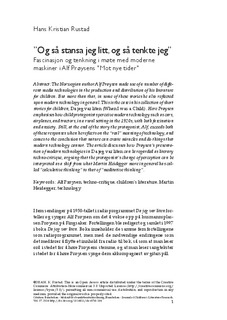”Og så stansa jeg litt, og så tenkte jeg” Fascinasjon og tenkning i møte med moderne maskiner i Alf Prøysens ”Mot nye tider”
Journal article, Peer reviewed

Åpne
Permanent lenke
http://hdl.handle.net/11250/277328Utgivelsesdato
2014Metadata
Vis full innførselSamlinger
Originalversjon
Rustad, H. K. S. (2014). ”Og så stansa jeg litt, og så tenkte jeg”. Fascinasjon og tenkning i møte med moderne maskiner i Alf Prøysens ”Mot nye tider”. Barnboken, 37. doi: 10.14811/clr.v37i0.184 10.14811/clr.v37i0.184Sammendrag
Abstract: The Norwegian author Alf Prøysen made use of a number of different
media technologies in the production and distribution of his literature
for children. But more than that, in some of these stories he also reflected
upon modern technology in general. This is the case in his collection of short
stories for children, Da jeg var liten (When I was a Child). Here Prøysen
emphasises how child protagonists perceive modern technology such as cars,
airplanes, and tractors, in a rural setting in the 1920s, with both fascination
and anxiety. Still, at the end of the story the protagonist, Alf, exceeds both
of these responses when he reflects on the “real” meaning of technology, and
comes to the conclusion that nature can create miracles and do things that
modern technology cannot. The article discusses how Prøysen’s presentation
of modern technologies in Da jeg var liten can be regarded as literary
techno-critique, arguing that the protagonist’s change of perception can be
interpreted as a shift from what Martin Heidegger more in general has called
”calculative thinking” to that of ”meditative thinking”.
Beskrivelse
This is an Open Access article published in Barnboken and distributed under the terms of the Creative Commons Attribution-Noncommercial 3.0 Unported License (http://creativecommons.org/licenses/by-nc/3.0/), permitting all non-commercial use, distribution, and reproduction in any medium, provided the original work is properly cited.. You can access the article on publisher's website by following this link: http://www.barnboken.net/index.php/clr/article/view/184/html_13